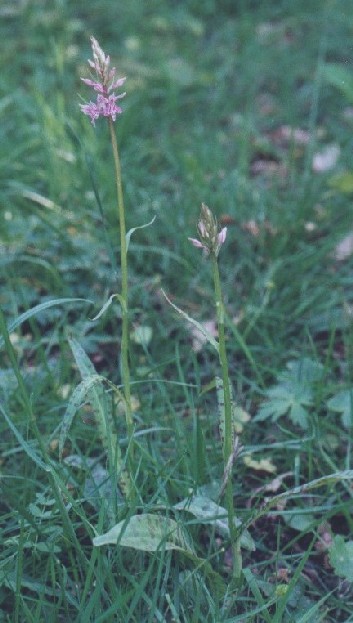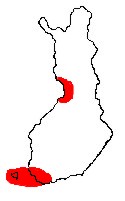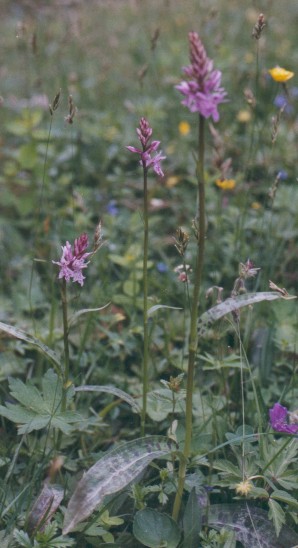
 Dactylorhiza
(maculata ssp.) fuchsii, kalkkimaariankämmekkä
Dactylorhiza
(maculata ssp.) fuchsii, kalkkimaariankämmekkä
In Finland this is propably the only orchid that is really closely related
to D. maculata. It is still guite easy to tell them apart.
D. fuchsii usually grows in croves, when D. maculata needs
Picea-woods and marshes. Both species can also be found along roads.
The lowest leaf of D. fuchsii is usually round at its tip (it is
often round in D. maculata´s, too). D. fuchsiis are on average  little
darker in colour than D. maculata. D. fuchsii also has different
shape of the inflorescense: it is more or less pyramid-shaped when the
flowering is just about to start, while D. maculata has cylindar
shape. All the lobes in the lip of D. fuchsii are about the same
size, in D. maculata the mid-lope is significaly smaller than othe
lopes. But the most important way to tell these plants apart is this: D.
fuchsii does not vary too much, the colour may be little different
in different specimens, but plants look guite a lot the same. D. maculata,
instead, varies very much. There are always weird specimens with D.
maculatas, so if someone finds plant that maches perfectly for D.
fuchsii, and most of the plants around it look like D. maculata´s,
the plant is propably no more than just one more D. maculata.
little
darker in colour than D. maculata. D. fuchsii also has different
shape of the inflorescense: it is more or less pyramid-shaped when the
flowering is just about to start, while D. maculata has cylindar
shape. All the lobes in the lip of D. fuchsii are about the same
size, in D. maculata the mid-lope is significaly smaller than othe
lopes. But the most important way to tell these plants apart is this: D.
fuchsii does not vary too much, the colour may be little different
in different specimens, but plants look guite a lot the same. D. maculata,
instead, varies very much. There are always weird specimens with D.
maculatas, so if someone finds plant that maches perfectly for D.
fuchsii, and most of the plants around it look like D. maculata´s,
the plant is propably no more than just one more D. maculata.
The species is common in Ahvenanmaa, but other places where it grows are poorly known. It would be important to check all the Dactylorhiza-populations in case that this species could be found. With only some practising it is easy to tell it apart from other Dactylorhizas. For sure it can be said to be growing in Hanko and Keminmaa, but it might even be guite common in some other areas, too.
In Ahvenanmaa the species flowers from early June forwads. The flowering.time
is guite propably absolutely same as with D. maculata.

